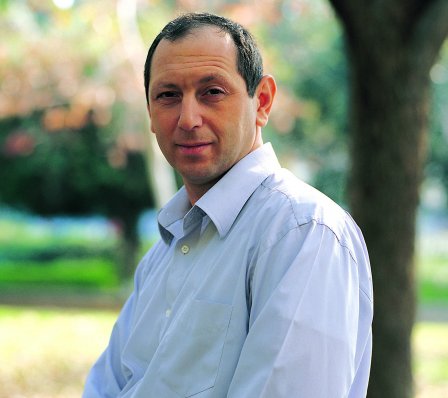"When we talk about energy, we're talking about our culture as a civilization of materials," says Prof. Igor Lubomirsky of the Weizmann Institute of Science's Department of Materials and Interfaces. Most of the energy we consume, he explains, has nothing to do with gasoline or electricity, but is devoured through materials.

Every time we use a plastic bag, eat a meal, or ride in an elevator, we take advantage of the energy invested in those materials. "Since people around the world want more materials to consume, the main question is how to generate energy without self-destruction," says Prof. Lubomirsky. "We have to find a way to produce it without burning fossil fuels and poisoning everything around us."
Prof. Lubomirsky, a researcher in the cutting-edge field of nanoscience, brings a background in materials science to his investigations of ways to diversify our energy supply. For example, he discovered that, under certain conditions, a common ceramic material called cerium gadolinium oxide behaves more like rubber than like a regular ceramic. It adjusts to an externally imposed shape, but returns to its original form once released from its constraints. And unlike an average ceramic, it does not buckle when heated or crack when cooled. The ceramic's ability to adapt to all temperatures could be useful in devices that undergo repetitive warming and cooling, such as fuel cells that convert chemical energy directly into electricity.
With regard to alternative energy, Prof. Lubomirsky is especially interested in solving a fundamental problem: how to convert a low-density energy source to one that is high density. Wind and solar power—currently the most promising forms of renewable energy—are very dilute compared to fossil fuels, which means that it may take a large surface area, many hours, and certain weather conditions to collect the energy at a practical rate. "As a society, we've never tried to switch from concentrated energy sources to dilute ones," he says. "Ideally, we should try to harvest energy from the wind and sun and convert it to something we can use in the same ways we use fuel now."
With the support of the Weizmann Institute's Alternative Energy Research Initiative (AERI), Prof. Lubomirsky is working toward this goal. He is trying to develop a method of storing and transporting wind and solar power. One of the main reasons these cheap, non-polluting energy sources have not yet been used on large scales is that today's technologies convert them to electricity or heat on the spot, and the power is then fed directly into the home or community where the equipment is sited and cannot be transmitted to faraway populations. Further complicating the situation is the fact that the best locations for exploiting these types of energy tend to be under-populated, such as deserts or the middle of an ocean.
One of Prof. Lubomirsky's solutions is to use electricity generated from the wind or sun to power the production of chemical fuel, which is a moveable form of stored energy. He is interested in a chemical reaction that would split molecules of carbon dioxide (CO2) to create carbon monoxide and oxygen. The carbon monoxide could then be easily transported to where it is needed, or converted by another simple chemical reaction into fuel for use in vehicles or power stations.
As splitting CO2 molecules directly is extremely inefficient, Prof. Lubomirsky is developing an alternative process in which CO2 is first converted into a cheap, reusable intermediate product such as soda (a common, naturally occurring mineral compound), and then split into oxygen and carbon monoxide by electrical current.
He hopes to develop a chemical process that is stable over time, non-polluting, and requires minimal maintenance. Because the gases CO2 and carbon monoxide are easy to transport, plants for producing the carbon monoxide could be located in sparsely populated deserts. They could also be anchored in oceans, where steady, year-round winds provide a constant energy source.
Prof. Lubomirsky points out that searching for new ideas on how to use renewable energy sources and adapt them to our existing infrastructure is something that the Weizmann Institute, as a basic research institution, is uniquely positioned to do. And these ideas are essential, he says, because "we cannot solve our energy problems with the same logic we used to create them. Now we need new logic."
Prof. Igor Lubomirsky's research is supported by the Nancy and Stephen Grand Research Center for Sensors and Security; Mr. Martin Kushner Schnur, Mexico; Mr. Rowland Schaefer, New York, NY; and Mr. and Mrs. Yossie Hollander, Israel. The Weizmann Institute of Science in Rehovot, Israel, is one of the world's foremost centers of scientific research and graduate study. The American Committee for the Weizmann Institute of Science is a community of dedicated people who share a common vision in support of the Institute. The generous assistance the Institute receives from individuals, foundations, and corporations is vital for its future. Committee members show their devotion to the advancement of the Institute's goals by becoming partners in the search for answers to the most difficult challenges facing humanity.
